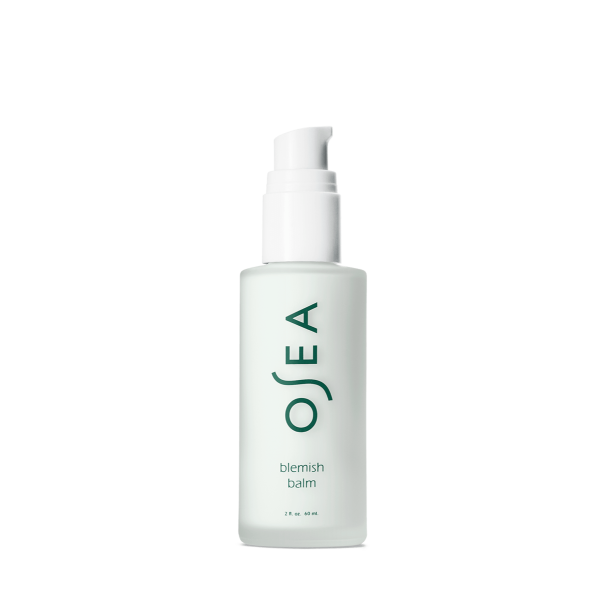Vitamin, mineral, and nutrient-rich oil-balancing blemish balm with algae, tea tree, grapeseed, jojoba, and additional essential oils
Targets excess oil production in the skin, while promoting balanced hydration Soothing botanicals calm and cleanse the skin Ideal for blemish-prone, oily, and combination skin Lightweight, non-drying formula leaves the skin feeling refreshed Gently moisturizes the skin and visibly minimizes pore size and breakouts Vegan Cruelty free Leaping Bunny certified Paraben free Free of artificial fragrances, synthetic ingredients, and dyes
Ingredients Concern: Melaleuca alternifolia (tea tree) leaf oil
Cons: Melaleuca alternifolia (tea tree) leaf oil has an EWG rating of 6 due to its potential to cause skin irritation and swelling. This only pertains to tea tree leaf oil, not tea tree leaf powder, water, the leaf, or leaf extract
Algae demonstrates detoxifying, hydrating, moisturizing, and occlusive properties that lower the loss of water from the skin [1].
Rosemary oil and tea tree oil target a substance called dihydrotestosterone (DHT) that is associated with sebum (oil) buildup [2, 3]. Jojoba oil helps loosen and promote the removal of sebum from the skin, which is a thick, oily substance that is linked to skin problems for some individuals [4].
Grapeseed helps improve firmness and skin tone, thereby targeting the signs of premature aging [5, 6].
Juniper fruit helps balance the release of an oily substance called sebum, which promotes a clearer, more even skin tone [7].
Thymol is the main monoterpene phenol (antioxidant) found in the essential oils of various plants belonging to the Lamiaceae family, including the Thymus plant [8].
Skin moisturization [1-7], targets oily, acne-prone, and combination skin [1-7], blemish reduction [1-5]
Algae use significantly decreases trans-epidermal water loss, helps draw impurities out of the skin, and heightens moisture retention in the skin [1]. In particular, it helps detoxify the skin by drawing out toxins, while delivering essential minerals to the skin.
Rosemary oil and tea tree oil block dihydrotestosterone (DHT) activity, thereby preventing the buildup of sebum [2, 3]. Jojoba oil mimics the texture of sebum and this reduces the production of sebum on the skin [4].
Grapeseed has skin-smoothing, photoreceptor enhancing, and inflammatory-pathway influencing properties [5, 6]. This helps the outer layer of the skin maintain its moisture, and it accelerates skin cell rejuvenation [6]. These antioxidant compounds also influence collagen levels by supporting the production of collagen and elastin fibers, which helps targets the appearance of premature aging (e.g., wrinkles) [5, 6].
Juniper fruit helps maintain overall skin quality by softening the skin and scavenging free radicals that can disrupt proper sebum (oil) production [7]. This problem is linked to abnormal inflammatory responses and blemishes.
Thymol has antiseptic, antibacterial, and antifungal properties, all of which make it beneficial for cleansing the surface of the skin [8].
Note regarding the Strength, Results, and Safety: All types of algae are prone to oxidation upon exposure to air and light, particularly when packaged in light containers or glass. This product is in what appears to be a clear container, which indicates that the algae component may not maintain stability for extended periods. Grapeseed, jojoba, and tea tree are among the first set of ingredients listed, meaning they help confer most of the benefits. In terms of safety, all of the ingredients have EWG ratings of 2 or less. Melaleuca Alternifolia (Tea Tree) Leaf Oil has an EWG rating of 6 due to its potential to cause skin irritation and swelling. This only pertains to tea tree leaf oil, not tea tree leaf powder, water, the leaf, or leaf extract.
Key Ingredients: Algae, Tea tree, Grape seed, Juniper, Jojoba, Rosemary, and Thyme oils
All Ingredients: Aqua, Gigartina Skottsbergii Algae, Macrocystis Pyrifera Algae, Undaria Pinnatifida Algae, Vitis Vinifera (Grape) Seed Oil, Caprylic/Capric Triglyceride, Glycerin, Propanediol, Cetearyl Olivate, Simmondsia Chinensis Oil (Jojoba Seed Oil), Sorbitan Olivate, Melaleuca Alternifolia (Tea Tree) Leaf Oil, Saccharomyces/Copper Ferment, Rosmarinus Officinalis (Rosemary) Leaf Oil, Saccharomyces/Manganese Ferment, Lavandula Angustifolia (Lavender) Oil, Saccharomyces/Zinc Ferment, Juniperus Communis (Juniper) Leaf Oil, Glyceryl Stearate, Thymus vulgaris Oil, Cetearyl Alcohol, Cupressus Sempervirens (Cypress) Essential Oil, Stearic Acid, Citrus Grandis (Grapefruit) Peel Oil, Sodium Lauroyl Glutamate, Xanthan Gum, Guar Gum, Citric Acid, Lonicera Caprifolium Extract, Lonicera Japonica Extract
 
After cleansing skin, use Essential Corrective Complex where your skin needs extra love. Apply your preferred serum. Massage Blemish Balm into skin until thoroughly absorbed. Use morning and night.
Pro Tip: Use Blemish Balm as a refreshing after shave lotion to calm the skin and soothe razor bumps.
These statements have not been evaluated by the FDA. These products are not intended to diagnose, treat, cure or prevent any disease.
1. De Luca M, et al. Lipids from Microalgae for Cosmetic Applications. Cosmetics. 2021; 8 52.
2. Nieto G, Ros G, Castillo J. Antioxidant and Antimicrobial Properties of Rosemary (Rosmarinus officinalis, L.): A Review. Medicines (Basel). 2018;5(3):E98.
3. Henley DV, Lipson N, et al. Prepubertal gynecomastia linked to Lavender and tea tree oil. N Engl J Med. 2007;356:479-485.
4. Sandha GK, Swami VK. Jojoba oil as an organic, shelf stable standard oil-phase base for cosmetic industry.2009;2(2):300-306.
5. Shivananda NB, et al. Wound-healing properties of the oils of Vitis vinifera and Vaccinium macrocarpon. Phytother. Res. 2011;25:1201-1208.
6. Lin TK, Zhong L, Santiago JL. Anti-Inflammatory and Skin Barrier Repair Effects of Topical Application of Some Plant Oils. Int J Mol Sci. 2017;19(1):E70.
7. Raina R, et al. Potential of Juniperus communis L as a nutraceutical in human and veterinary medicine. Heliyon. 2019;5(8):e02376.
8. Marchese A, Orhan IE, et al. Antibacterial and antifungal activities of thymol: A brief review of the literature. Food Chem. 2016;210:402-14.


